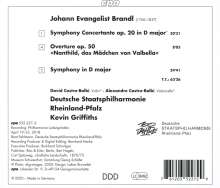Johann Evangelist Brandl: Sinfonia concertante op.20 auf CD
Sinfonia concertante op.20
Herkömmliche CD, die mit allen CD-Playern und Computerlaufwerken, aber auch mit den meisten SACD- oder Multiplayern abspielbar ist.

+Symphonie D-Dur; Nanthild, das Mädchen von Valbella-Ouvertüre op. 50
- Künstler:
- David Castro-Balbi, Alexandre Castro-Balbi, Deutsche Staatsphilharmonie Rheinland-Pfalz, Kevin Griffiths
- Label:
- CPO
- Aufnahmejahr ca.:
- 2018
- Artikelnummer:
- 9254301
- UPC/EAN:
- 0761203522729
- Erscheinungstermin:
- 27.1.2020
Unerhört Virtuoses zwischen Klassik und Romantik Vol. 2
Als Johann Evangelist Brandl die „Symphonie concertante“ op. 20 schrieb, konnte er sich mehr aufs Komponieren frei von höfischen Anlässen und damit auf das Ausloten seiner Fähigkeiten denn aufs Planen und Durchführen von Konzerten konzentrieren. Seine „Symphonie concertante“ kann daher ebenso wie jene von Mozart als eine Art Visitenkarte verstanden werden, mit der Brandl seine Fühler weiter nach Festanstellungen ausstreckte. Wie Mozart lässt auch Brandl in seinem Werk mit zwei Soloinstrumenten die Dimensionen des ersten Satzes gegenüber einem Solo-Konzert erkennbar anwachsen und gibt so beiden Solisten Raum und Zeit, alle Themen und Motive nacheinander vorzustellen und im Übrigen durchaus virtuos zu verarbeiten. Was unsere beiden Solisten, die Brüder Castro-Balbi hier an atemberaubender Virtuosität zeigen, ist schlicht sensationell. Seine ca. 10 Jahre früher entstandene viersätzige Sinfonie D-Dur komponierte Brandl mit ihrem fulminanten Finale als „Grande Simphonie à grand Orchestre“ Schon damals nahm Brandl viel von Beethovens erst 1806 vollendeter Vierter op. 60 vorweg. Etwas vom Aufbruch zu neuen Klangwelten, wie er dem Rheinländer Beethoven vorschwebte, ist auch bei dem zehn Jahre älteren Brandl zu spüren. Heute entdeckt die Forschung in Brandl einen Künstler, dessen Tonsprache vor allem gegen Ende seines Schaffens den Stil der Klassik zugunsten einer geschärften Chromatik überwindet und bereits frühromantische Züge aufweist.
Product Information
Unheard-of Virtuosity between Classicism and Romanticism Vol. 2
When Johann Evangelist Brandl wrote his Symphonie concertante op. 20, he had more time to concentrate on composing free of court occasions and to exploit in full his own capabilities rather than focusing on the planning and performing of concerts. Therefore his Symphonie concertante, like the one by Mozart, can be viewed as a sort of visiting card, and with it Brandl wanted to put out his feelers in quest of new appointments. Like Mozart, in his work with two solo instruments Brandl has the dimensions of the first movement noticeably expand in view of the solo concerto and in this way gives both soloists space and time to present all the themes and motifs in succession as well as to elaborate them with great virtuosity. What our two soloists, the Castro-Balbi brothers, display in breathtaking virtuosity is simply sensational. Brandl had composed his four-movement Symphony in D major with a dazzling finale as a »Grande Simphonie à grand Orchestre« some ten years earlier. Already then Brandl anticipated a lot of Beethoven’s Fourth Symphony op. 60, which first was completed in 1806. Something of the quest for new sound worlds that the Rhinelander Beethoven envisioned is also in evidence in Brandl, who was ten years his senior. Today musicologists are discovering in Brandl an artist whose musical language above all toward the end of his creative career surmounted the style of Classicism and instead favored a sharpened chromaticism and already exhibited Early Romantic characteristics.
Disk 1 von 1 (CD)
Konzertsinfonie D-Dur op. 20
-
1 1. Adagio - Allegro
-
2 2. Andante quasi un poco allegretto
-
3 3. Polonaise
-
4 Nanthild, das Mädchen von Valbella op. 50 (Ouvertüre)
Sinfonie D-Dur
-
5 1. Allegro con spirito
-
6 2. Andante
-
7 3. Menuett: Allegretto - Trio
-
8 4. Presto
Mehr von Johann Evangeli...












